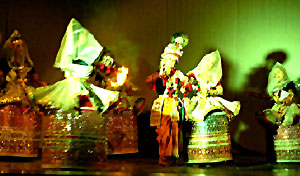 The literal meaning of Sanseba is `tending the cows` or Gostha Lila. This is a traditional Manipuri children`s theatre, normally falling on Gostha Ashtami i.e. the eighth lunar day of Hiyangei or November. It developed in the mid-eighteenth century, though the origins of the play and its creator remain unrecorded. Oral traditions, however, allude to King Chingthangkhomba, alias Bhagyachandra during 1763-98. He introduced Ras Lila in Manipur. The royal chronicles mention an event in 1803, when during an outing, the wooden bridge on the Imphal River broke and a troupe member died in the accident. Brajabuli and Sanskrit were often the medium of communication, which changed to Manipuri in the early twentieth century.
The literal meaning of Sanseba is `tending the cows` or Gostha Lila. This is a traditional Manipuri children`s theatre, normally falling on Gostha Ashtami i.e. the eighth lunar day of Hiyangei or November. It developed in the mid-eighteenth century, though the origins of the play and its creator remain unrecorded. Oral traditions, however, allude to King Chingthangkhomba, alias Bhagyachandra during 1763-98. He introduced Ras Lila in Manipur. The royal chronicles mention an event in 1803, when during an outing, the wooden bridge on the Imphal River broke and a troupe member died in the accident. Brajabuli and Sanskrit were often the medium of communication, which changed to Manipuri in the early twentieth century.
The form depicts Krishna`s experiences as a cowherd. His becoming ready to tend cows at the age of 5, Narada`s advent at Gokul, and Krishna beseeching his foster-father to let him look after the cows with his friends. After much argument and feasting, the children go out to a forest where Krishna and his elder brother Balaram kill the demons Bakasur and Dhenukasur respectively. They return when the cows go back to their sheds. The story is taken from cantos eleven and fifteen in the tenth book of the Bhagavata Purana. A clown, Balabasu, who was attached to Narada was incorporated to provide bland jokes and improvised humour. Similar to the Bahua in the Ankiya Bhaona of Assam, Balabasu however was outspoken and adamant, not usually silent as his Assamese counterpart. Sansenba combines fun, frolic, adventure, and environmental enactment, with demons in body-size masks and ritual worship at the end in the evening. The young Krishna`s exploits are very popular, and games, theatrics, and children`s linguistic interplay entertain. The mother`s role provides real scope to actresses.
This article is a stub. You can enrich by adding more information to it. Send your Write Up to content@indianetzone.com




















